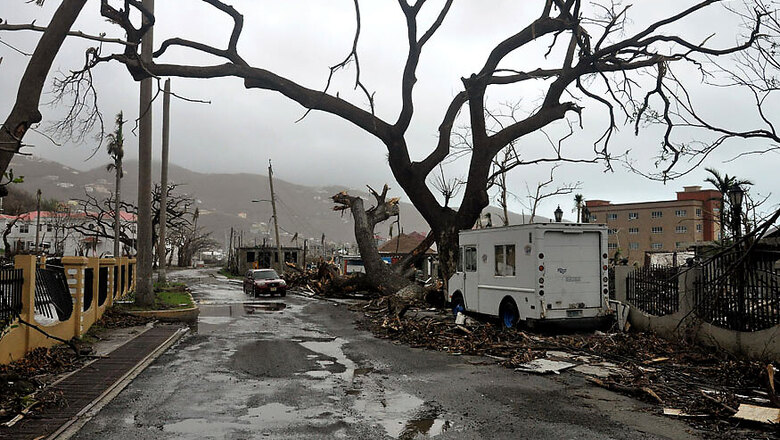
views
San Juan, Puerto Rico: The strongest hurricane to hit Puerto Rico in more than 80 years destroyed hundreds of homes, knocked out power across the entire island and turned some streets into raging rivers Wednesday in an onslaught that could plunge the U.S. territory deeper into financial crisis.
Leaving at least nine people dead in its wake across the Caribbean, Hurricane Maria blew ashore in the morning near the southeast coastal town of Yabucoa as a Category 4 storm with winds of 155 mph (250 kph).
It punished the island of 3.4 million people with life-threatening winds for several hours, the second time in two weeks that Puerto Rico has felt the wrath of a hurricane.
"Once we're able to go outside, we're going to find our island destroyed," warned Abner Gomez, Puerto Rico's emergency management director. "The information we have received is not encouraging. It's a system that has destroyed everything in its path."
As people waited in shelters or took cover inside stairwells, bathrooms and closets, Maria brought down cell towers and power lines, snapped trees, tore off roofs and unloaded at least 20 inches (50 centimeters) of rain.
Widespread flooding was reported, with dozens of cars half-submerged in some neighborhoods and many streets turned into rivers. People calling local radio stations reported that doors were being torn off their hinges and a water tank flew away.
Felix Delgado, mayor of the northern coastal city of Catano, told The Associated Press that 80 percent of the 454 homes in a neighborhood known as Juana Matos were destroyed. The fishing community near San Juan Bay was hit with a storm surge of more than 4 feet (1.2 meters), he said.
"Months and months and months and months are going to pass before we can recover from this," he said.
Gov. Ricardo Rossello imposed a curfew from 6 p.m. to 6 a.m. daily until Saturday to allow rescue crews and officials to respond to the hurricane's aftermath.
"We are at a critical moment in the effort to help thousands of Puerto Ricans that urgently need aid and to assess the great damage caused by Hurricane Maria," he said. "Maintaining public order will be essential."
Rossello said in an interview on CNN's "Anderson Cooper 360" that one fatality has been reported but because communications were knocked out in some areas, the total casualty count wasn't known.
As of 8 p.m. EDT, Maria had weakened into a Category 2 hurricane with winds of 110 mph (175 kph). It was centered just off the northwestern corner of Puerto Rico, moving at 12 mph (19 kph).
It was expected to pass off the northeastern coast of the Dominican Republic late Wednesday and Thursday.
Even before the storm, Puerto Rico's electrical grid was crumbling and the island was in dire condition financially.
Puerto Rico is struggling to restructure a portion of its $73 billion debt, and the government has warned it is running out of money as it fights against furloughs and other austerity measures imposed by a federal board overseeing the island's finances.
Rossello urged people to have faith: "We are stronger than any hurricane. Together, we will rebuild."
He asked President Donald Trump to declare the island a disaster zone, a step that would open the way to federal aid.
Many people feared extended power outages would further sink businesses struggling amid a recession that has lasted more than a decade.
"This is going to be a disaster," said Jean Robert Auguste, who owns two French restaurants and sought shelter at a San Juan hotel. "We haven't made any money this month."
More than 11,000 people — and more than 580 pets — were in shelters, authorities said.
Along the island's northern coast, an emergency medical station in the town of Arecibo lost its roof, while communication was severed with several emergency management posts. A hospital and a police station reported broken windows, and a tree fell on an ambulance.
As the storm closed in on the Dominican Republic, about 4,000 tourists in the Bavara-Punta Cana area on the eastern tip of the island were moved to hotels in Santo Domingo, the capital. About 100 flights were canceled and the government suspended school and sent workers home.
"The government has prepared itself for the worst case scenario and so should the people," presidential administrative secretary Jose Ramon Peralta said.
Maria posed no immediate threat to the U.S. mainland. The long-range forecast showed the storm out in the Atlantic Ocean hundreds of miles off the Georgia-South Carolina coast by Monday morning.
Previously a Category 5 with 175 mph (281 kph) winds, Maria hit Puerto Rico as the third-strongest storm to make landfall in the U.S., based on its central pressure. It was even stronger than Hurricane Irma when Irma roared into the Florida Keys earlier this month.
Irma sideswiped Puerto Rico on Sept. 6, causing no deaths or widespread damage on the island but leaving more than 1 million people without electricity. More than 70,000 still had no power as Maria approached.
As Maria closed in, Trump offered his support via Twitter: "Puerto Rico being hit hard by new monster Hurricane. Be careful, our hearts are with you - will be there to help!"
The storm's center passed near or over St. Croix overnight Tuesday, prompting U.S. Virgin Islands Gov. Kenneth Mapp to warn people to sleep in their street clothes and shoes just in case. St. Croix was largely spared by Irma.
There were no immediate reports of deaths or injuries on St. Croix, but it was still too dangerous Wednesday to venture out and conduct a thorough check, said Nykole Tyson, a spokeswoman at the U.S. Virgin Islands Emergency Operations Center.
On the island of Dominica, which got slammed late Monday, Hartley Henry, an adviser to the prime minister, reported at least seven deaths and a "tremendous loss of housing and public buildings." He said the country was "in a daze," with no electricity and little to no communications.
Dominica's airport and seaports remained closed, and authorities used helicopters to carry emergency food, water and shelter materials to the island, said Ronald Jackson, head of the Caribbean Disaster and Emergency Management Agency.











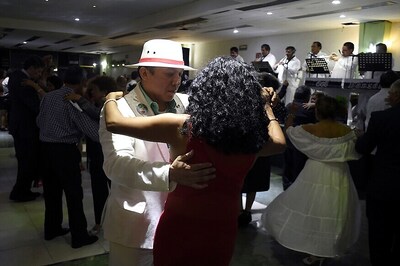

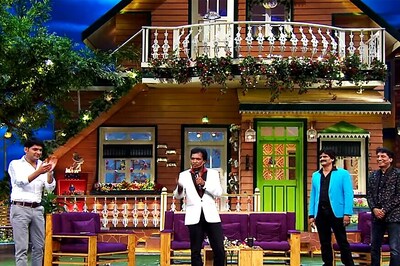

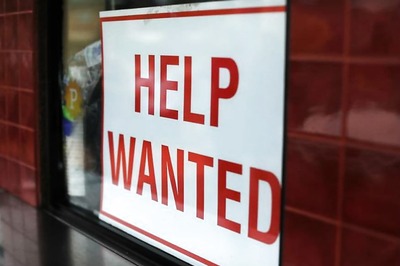


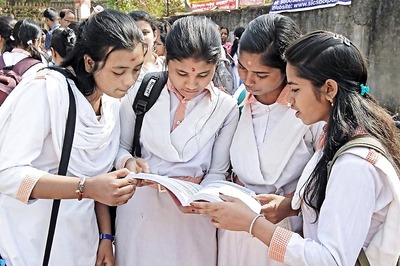

Comments
0 comment